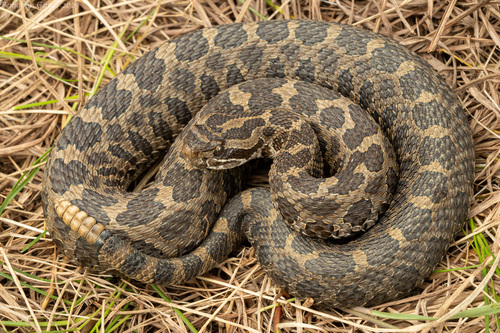
Massasauga Rattlesnake
The Eastern Massasauga, with its signature rattle and cryptic pattern, slithers silently through wetlands and prairies, a hidden guardian of the ecosystem. This elusive rattlesnake, often unnoticed, controls small mammal populations, embodying the delicate yet vital balance of nature's intricate web.
8-14 years
Lifespan
Length: 61 - 76 cm
Size
Brown, Grey, Black, Tan
Color
Least Concern
Conservation Status
Unknown
Population Trend
Characteristics
The Sistrurus catenatus, commonly known as the Eastern Massasauga rattlesnake, is a small, venomous pit viper. It inhabits wetlands and grasslands across the Midwest and Great Lakes region. Known for its distinctive rattle, this snake is generally reclusive and relies on its camouflage to avoid predators. It plays a crucial role in controlling small mammal populations, thus maintaining ecological balance.
Distribution Range of the Massasauga Rattlesnake
Sistrurus catenatus, commonly known as the Eastern Massasauga Rattlesnake, is native to North America. It is primarily found in the Great Lakes region, with its range spanning parts of the United States and Canada. In the United States, it is distributed across states including Ohio, Michigan, Indiana, Illinois, Iowa, Wisconsin, Minnesota, Missouri, New York, and Pennsylvania. In Canada, it is found in southern Ontario.
Massasauga Rattlesnake's Habitat
Environmental Conditions
The Eastern Massasauga Rattlesnake inhabits a variety of wetland and grassland environments. It is typically associated with areas that have a mix of open sunny spaces for basking, such as prairies, marshes, and floodplain forests, as well as nearby cover in the form of shrubs, tall grasses, or logs. This species thrives in environments with seasonal wet conditions, which support its prey base and provide suitable hibernation sites.
Ecological Niche
This rattlesnake plays an important ecological role as both a predator and prey species within its habitat. It primarily preys on small mammals, amphibians, and occasionally birds, helping to control the populations of these species. In turn, it serves as a food source for larger predators such as hawks and other mammals. The Eastern Massasauga is adapted to a relatively low-energy lifestyle, allowing it to survive in environments where prey might be patchily distributed.
Copyright @ Nature Style Limited. All Rights Reserved.
 English
English